by Lance Hill | Jul 12, 2022 | Mirliton
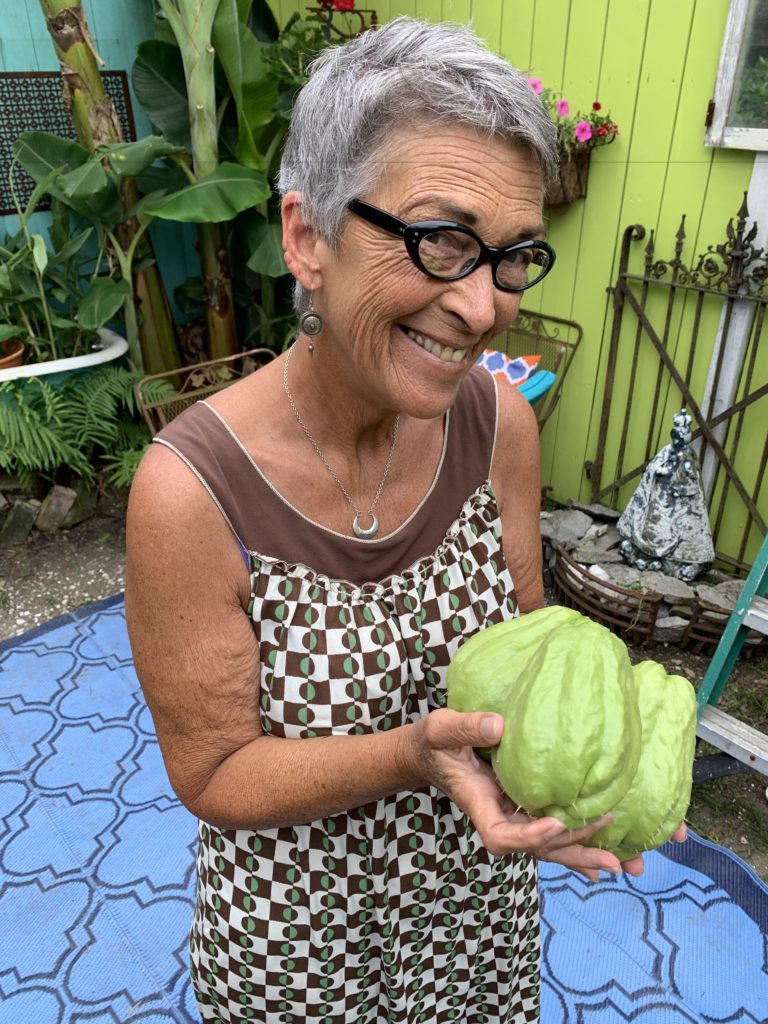
Debra Voelker (photo by Renee Lapeyrolerie)
By Renee Lapeyrolerie
Debra Voelker is Jazz Fest, Mardi Gras, costumes, and mirliton. She has roots on St. Ann Street and Ursulines Avenue. Her dad grew mirliton on Orleans Avenue and her maw maw stuffed them on Canal Street. About six years ago, Debra got mirliton seed from a friend who’d shared on a social media post that she’d put them ‘out for the taking’ from her front porch. The supplier said that she had gotten seed from an elder whose vine survived Hurricane Katrina’s winds, although we have not been able to verify the source nor the location.
However nice that would be to know, Debra’s vine has produced multiple years and she was even gifted a crop in the Summer of 2021. Surely, a Louisiana heirloom due to its reliable production and physical characteristics. Debra made a sweet mirliton pie and a soup with her bonus crop. It’s the Fall yield though that brings back memories of her mirliton-filled youth. Her maternal grandmother, or maw maw, who lived on Canal Street just two miles from where Debra now lives, stuffed her mirliton mixture back into the shells for baking, some with ground meat and others with shrimp. Debra makes a traditional stuffing and has added mozzarella, an idea she picked up from a friend. Her father’s sister used to cut mirliton up into big chunks and pickle them that way, after all, mirliton was plentiful in the family.
Debra’s dad grew a vine on the hurricane fence of the home she was raised in on Orleans Avenue near North Carrolton Avenue. She remembers the vine growing all along the fence and sometimes over the garage. She has vivid memories of accompanying him up the street to put bags of mirliton on the neighbors’ stoops. “There would be Schwegmann’s bags of them,” she said, “it was wild!” That is a common unit of measure among mirliton growers during the century-long era of a popular supermarket chain in the New Orleans region.
As we swapped stories about caring for our respective vines she lamented, “I don’t remember my dad doing a damn thing to his vine.” But she does remember a time that a mirliton tendril grabbed onto her hair. When Debra retrieved the mirliton from her friend, they were off-the-vine. She had to wait for them to sprout, she potted them, and got the vine going. For two years the vine produced fruit until a jealous dog interrupted progress in year three. She made another raised bed across the backyard and now both vines have produced and are thriving. Like most growers in the path of Hurricane Ida, her vine support was toppled, but she left it in place because she had fruit.
by Lance Hill | Jul 8, 2022 | Mirliton
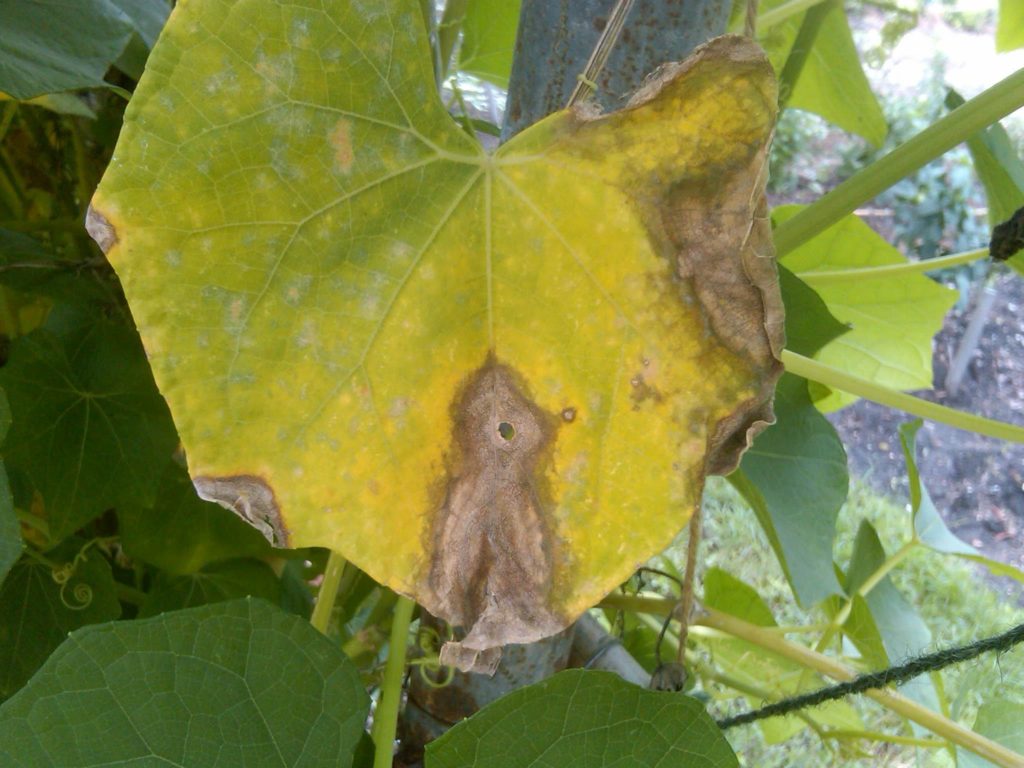
Mirliton leaf infected with anthracnose. Unlike powdery mildew which yellows uniformly and wilts the leaves, anthracnose starts as yellow wedges between the leaf veins. It then turns the leaf tissue brown and leaves a distinctive “shot hole” in the middle of the brown patches. This is because the anthracnose fungus feeds on both living and dead tissue.
Seasons change and diseases change. For mirlitons (chayote), the cooler, drier spring is time for the airborne mildews (powdery and downy), but the hot rainy months July through August—bring anthracnose season. Being prepared for it can significantly reduce the damage the disease might do.
First, know the enemy. The above photo provides all the classic signs of anthracnose; a yellow wedge that turns into dead paper-like tissue, with a shot-hole in the middle. If you got these, you got anthracnose.
Anthracnose is a disease caused by the fungus Colletotrichum lagenarium in mirlitons. There are many fungi that cause anthracnose disease, but for our purposes, we’ll call Colletotrichum lagenarium the “anthracnose fungus.” Unlike mildews which are carried by air, the anthracnose fungus is waterborne. That means it is carried by water droplets, splashing up from the soil and then from leaf to leaf. That’s important because it means that while you might be able to wash off some fungi with a good shower from your hose, the same shower will splash anthracnose fungus all over your vine and cause a massive anthracnose infection.
Three Steps to Manage Anthracnose:
- Don’t give your vine showers. Water from at the bottom of the vine with a hose set on low or drip irrigation.
- Don’t drown the vine. Too much soil moisture stresses mirliton and makes it difficult for it to fight fungi. Make sure your raised beds and ground plantings have adequate drainage, if they don’t have it, then add it now.
- Don’t worry; Be Happy. As horrible as anthracnose looks, infected vines normally recover in September and flower and fruit. Plus, they acquire increased resistance to the disease.
Here’s a more complete fact sheet on anthracnose and how to protect your plant by prepping your planting site or raised bed::Here
by Lance Hill | Jun 29, 2022 | How To, Mirliton
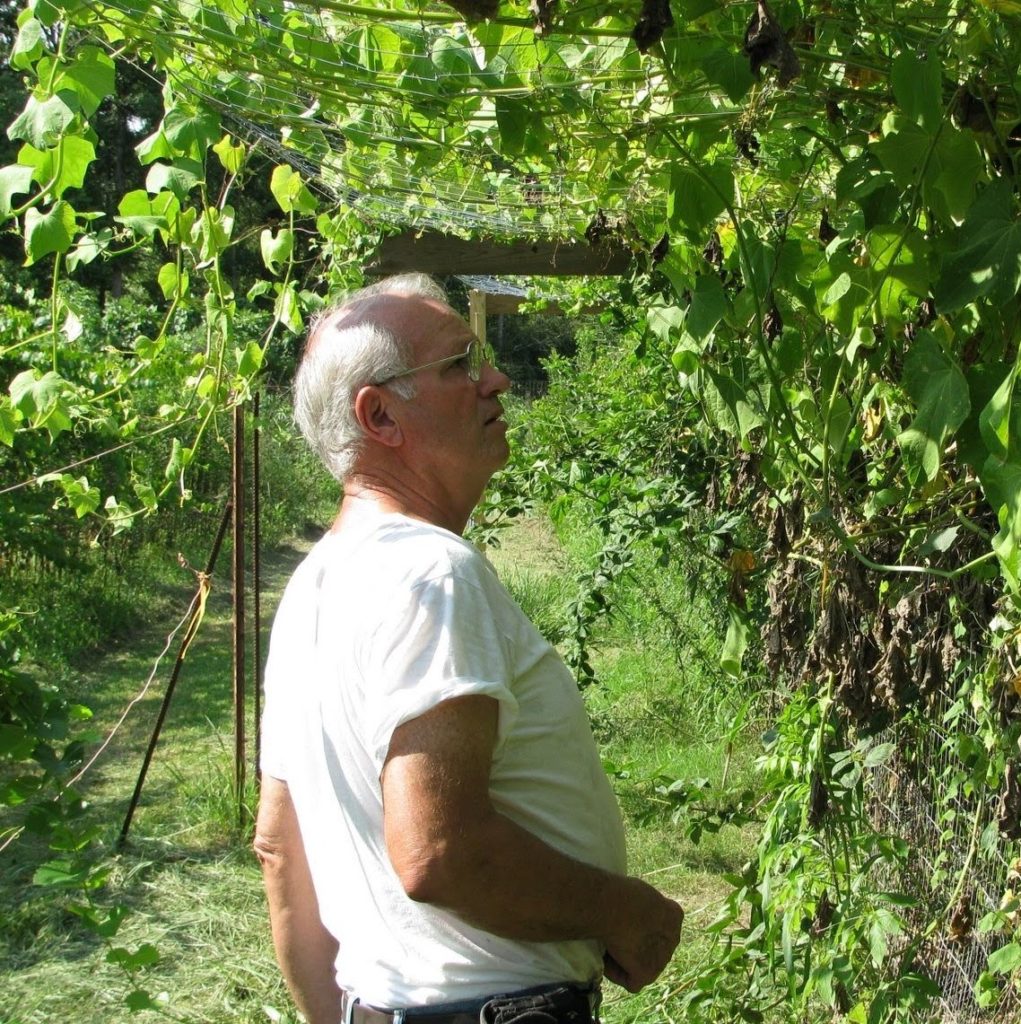
Ervin Crawford And his Mirliton Vine
In 2008, I was searching for a Louisiana heirloom mirliton to replace the variety I had grown since 1983. The hurricane Katrina flood had killed almost every mirliton in New Orleans. The usual suspects had given me all the normal bad advice: “Buy one at the grocery store. A mirliton is a mirliton. They’ll grow fine.” Nope. I planted, they died; I planted, they died. Over and over.
After a little research, I discovered there were scores of varieties—perhaps hundreds—each adapted to the particular climate and altitude. I had to find the one traditionally grown in Louisiana. I discovered that the Louisiana Department of Agriculture’s monthly Market Bulletin was digitally archived years back. I went through it looking under “fruits and vegetables for sale” and saw one name repeatedly; Ervin Crawford, Pumpkin Center. It was a long shot because the advertisements were decades old, but I called the number. Ervin Crawford answered.
I immediately drove to Pumpkin Center and met him. On that first visit, Ervin gave me about 20 mirlitons and with those 20 plants, I started Mirliton.Org. Ervin played a crucial role in saving the Louisiana heirloom mirliton.
Visiting Ervin’s farm is a pilgrimage everyone should make. He’s a retired airline mechanic and knows more about mirlitons than anyone I know. He has been growing them for five decades, first in Peal River where he was raised, and later in Pumpkin Center where he bought his 20-acre retirement farm. He grows everything; pecans, figs, beans, berries, bees, chickens.
He has a quality found in most successful gardeners–a healthy curiosity. He wanted to know why he had success as well as failures. And failure and mirlitons often go together in the poor sandy pinewoods soil of the area called the Florida Parishes. I have heard people in the region say, “They won’t grow up here.” At first, I thought that they were using the wrong variety, or planting them incorrectly. Ervin taught that the problem was not the soil, it was what was beneath the soil.
Soil sample tests tell you a great deal, but they won’t tell you what you need to successfully grow mirlitons. Mirlitons are shallow-root plants and they sink or swim depending on subsurface drainage. If the soil doesn’t drain quickly enough, the roots can’t absorb oxygen, and the plant founders or dies. Building a raised bed on top of poorly-drained soil may result in a mud boat. The bed has to have an outlet to either absorb or remove excess water. So to succeed, you need to know the geology and history of the land you are gardening on–and Ervin asked the right questions when he first got to Pumpkin Center.
Ervin learned that Pumpkin Center’s soil was considerably different from Pearl River, where he had learned gardening. Pearl River was a loamy basin soil, rich and porous. In contrast, Pumpkin Center was in the middle of the great Piney Flats that stretches from Florida to Texas. It was notoriously bad poor soil—sandy and acidic. When he once had some excavation work done, he saw that solid white clay lay a few feet down–a real barrier to drainage.
I realized that I had never asked those questions about where I was gardening. To grow mirlitons, you have to be part geologist, hydrologist, and historian. You don’t have to become an expert; just enough knowledge to benefit your mirliton.
As I learned more about the history of where I was gardening, I realized that my mirlitons had often thrived in spite of me. I never once had asked what was under that topsoil or what was there 100 years ago.
I do now, thanks to Ervin.
by Lance Hill | May 27, 2022 | How To, Mirliton
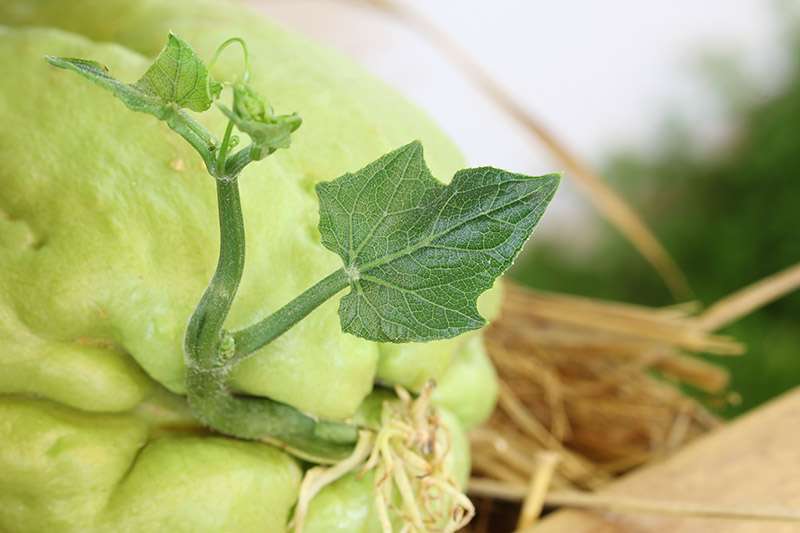
Spring mirlitons are normally sold unsprouted because they are picked fresh from the vine in early May. The first step before planting is to sprout the mirliton. You can speed the process by incubating it—keeping it as warm as possible. If it is above 80° outside, place the mirliton in a shaded area. Or you can incubate it inside your home by placing it in a small plastic trash can or 5-gallon container with a lamp or small heating pad on low. The ideal temperature is 80°-85°. This will promote rapid sprouting within 10-14 days. (here is how I did it)
As soon as the seed begins to emerge (sticks out its tongue), it needs to be planted—but differently from the fall ones. In May, temperatures can run in the 90s along the Gulf Coast, and I have found that sometimes they won’t send up a shoot in extreme heat. Instead, the shoot spirals under the seed. (Figure 1).
The solution is simple. Plant the sprout as you normally would, but put a temporary shade cover over it —a milk crate with a piece of shade cloth over it or a piece of cardboard on top will work fine. Cover the crate with chicken wire to ward off varmints. Once the shoot emerges, remove the crate and stake up the vine.
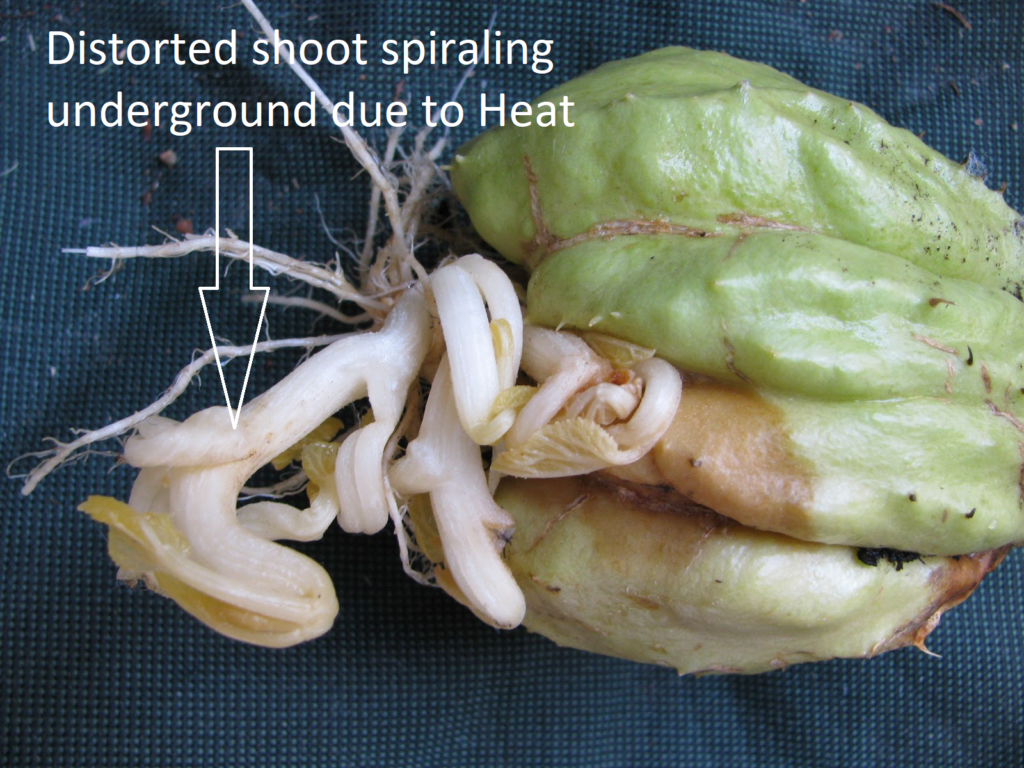
Figure 1.
by Lance Hill | Jan 8, 2021 | Mirliton

Chrissy and Ryan Rockefeller
Rockefeller Heirloom Mirliton Donated to Mirliton.Org
By Lance Hill
I am delighted to announce that Ryan and Chrissy Rockefeller of St. Rose, Louisiana have donated several sprouts to Mirliton.Org to propagate. This is a previously unseen dark green and slightly spiny variety.

Image 1. Rockefeller Heirloom Mirliton.
Chrissy Missios Rockefeller has been regularly posting about their mirliton vine on the Louisiana Edible Gardeners Facebook group. We were intrigued that it produced some dark green and spiny mirlitons. Similar varieties exist throughout the word, but Louisiana growers have favored pale green and smooth varieties. Somehow this variety survived. Mirliton.Org plans to carefully cultivate this variety to preserve and repopulate it. We have, as is our practice, named the variety after the family that had owned and preserved it for years.

Image 2. Rockefeller Heirloom Mirliton Vine growing in St. Rose.
People often ask us if different varietal colors and characteristics indicate differences in flavor. Imported mirlitons (chayote) have been selected for uniform color, size, and smoothness, all at the expense of flavor. We know that there are differences in flavor in Louisiana-grown heirlooms and plan to flavor- test the Rockefeller variety.

Image 3. Rockefeller Heirloom Mirliton sprouts.
If you are interested in growing the variety to provide it to aspiring growers, and if you have adequate trellis space and frost protection in place, please email me at lance@mirlton.org for an application.
Special thanks to Paul D’Anna for his help in securing this donation.









Recent Comments